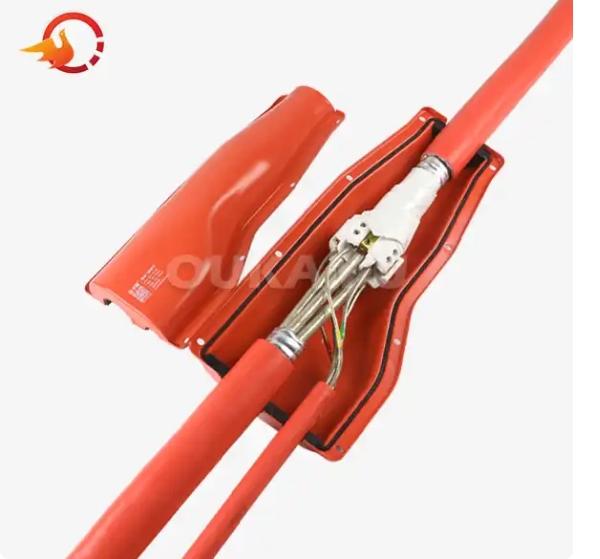When it comes to electrical installations, ensuring that your cables are securely and safely joined is critical. Whether you're working in a residential, commercial, or industrial setting, the right cable joint plays a crucial role in maintaining the safety, performance, and longevity of the system. Armoured cable joints are particularly essential in environments where additional protection from physical damage, moisture, and other environmental hazards is required. But with so many options available, how do you choose the right armoured cable joint for your project?
In this guide, OUKAMU will help you navigate the key considerations for selecting armoured cable joints that best suit your needs. From understanding the different types of armoured cable joints to evaluating their specific features and benefits, we’ll cover everything you need to know to make an informed decision.
1. What is an Armoured Cable Joint, and Why Is It Necessary?
An armoured cable joint is a specialized connector used to join armoured cables together in a safe and efficient manner. Armoured cables are designed to offer increased protection against external physical damage, moisture, and electrical interference. These cables are typically encased in a layer of steel or aluminium armour, which acts as a shield for the internal electrical conductors. When you need to join multiple armoured cables, the cable joint must be capable of maintaining the integrity of the armour while ensuring a secure electrical connection.
Why Armoured Cable Joints Are Necessary:
Armoured cable joints are essential in environments where cables face mechanical stress, moisture, or other hazards. Without the correct joint, the armour could be damaged, leading to potential safety hazards like electrical shorts, shocks, or fires. Armoured cable joints ensure that these external protections are preserved, and that the electrical system remains operational and safe over time.
These joints not only provide electrical continuity but also maintain the physical protection of the cable, which is especially important for underground installations, industrial environments, and outdoor projects.
Key Features of an Armoured Cable Joint:
- Protection for the Cable's Armour: The joint must allow the steel or aluminium armour to continue uninterrupted between the cables.
- Waterproofing and Sealing: Armoured cable joints often have waterproof seals that prevent moisture from entering the cable.
- Durability: The joint should be able to withstand extreme weather conditions, vibrations, and physical impacts.
Armoured cable joints are designed to meet specific needs in different sectors, from residential buildings to large industrial facilities. Their durability and safety features make them a reliable choice for challenging installations.
2. What Are the Different Types of Armoured Cable Joints Available?
When selecting the right armoured cable joint for your project, it’s important to understand the different types available. Armoured cable joints can be classified based on their construction, the materials they are made from, and their intended use. Below are some of the most common types of armoured cable joints you might encounter.
1. Straight-through Joints:
These are the most common type of armoured cable joint, used to connect two ends of a cable together. They are typically employed in outdoor and underground environments where cables need to be extended or connected to one another.
2. T-branch Joints:
These joints allow the branching of one armoured cable into two or more cables, often used when an electrical system needs to distribute power to multiple locations from a single cable source.
3. End Caps:
These joints are designed to seal the ends of armoured cables, preventing moisture or debris from entering the cable’s core when the cable is cut or the system is no longer active.
4. Splice Joints:
Splice joints are used to join cables that are already cut or damaged, ensuring that the electrical conductors are connected safely and without interruption.
5. Terminal Joints:
Terminal joints are used to connect the armoured cable to an electrical device or junction box, making them an essential part of any electrical installation in a residential or industrial setting.
Material Choices:
The materials used in the construction of armoured cable joints vary, depending on the type of cable and the environment. Common materials include:
- PVC (Polyvinyl Chloride): For moisture and chemical resistance.
- Rubber: For flexibility and insulation.
- Steel or Aluminium: For mechanical protection.
Understanding the different types of joints and the materials they’re made from will help you choose the best one for your specific application, ensuring optimal performance and safety.
3. How Do Environmental Conditions Affect the Choice of Armoured Cable Joints?
Environmental conditions play a significant role in determining the type of armoured cable joint you should choose. Whether the installation is outdoors, underground, or in an industrial environment, the joint must be able to withstand specific environmental challenges to ensure the system’s longevity and reliability.
1. Outdoor Installations:
For outdoor installations, the joint must be capable of withstanding various weather conditions, including rain, snow, humidity, and UV radiation. The joint should be sealed tightly to prevent moisture from entering the cable and causing corrosion. Waterproof and UV-resistant materials are essential for outdoor environments.
2. Underground Installations:
Underground installations face additional challenges such as moisture, chemical exposure, and potential damage from external forces. Armoured cable joints for underground use should feature heavy-duty sealing to protect the cable from water ingress. They should also be resistant to the chemicals commonly found in the soil, like salts or acids, which could degrade the cable’s integrity over time.
3. Industrial and Hazardous Environments:
In industrial settings, cables may be exposed to extreme temperatures, vibrations, and even physical impacts from machinery or heavy equipment. Armoured cable joints used in these environments need to be robust and resistant to physical stress, high temperatures, and potentially hazardous substances. High-quality insulation and a durable outer layer are crucial in these settings.
4. Corrosive Environments:
If your installation is in an area with a high level of corrosion (like coastal regions or industrial plants), corrosion-resistant armoured cable joints made from materials like stainless steel or zinc-plated steel are necessary. These joints can help prevent the deterioration of the armour and the internal conductors.
By considering these environmental factors, you can select a joint that will provide the necessary protection and durability for your project, ensuring that the cable system remains safe and functional for the long term.
4. How to Properly Install an Armoured Cable Joint?
Proper installation of an armoured cable joint is crucial for ensuring safety and reliability. A poorly installed joint can lead to electrical faults, moisture ingress, or physical damage. Here are some general guidelines for installing armoured cable joints correctly.
Step-by-Step Installation Process:
-
Preparation:
- First, ensure that all power to the cable is turned off. Safety is paramount during any electrical work.
- Cut the armoured cable cleanly, ensuring the conductors are not damaged during the cutting process.
-
Strip the Cable:
- Remove the outer sheath of the cable, exposing the armour and insulation underneath.
- Be careful not to damage the internal wires while stripping the cable.
-
Install the Cable Joint:
- Insert the exposed conductors into the joint and secure them with the appropriate fittings.
- Make sure the armour is also properly aligned with the joint's armour connector, ensuring the mechanical protection continues uninterrupted.
-
Seal the Joint:
- Use the provided sealing materials (such as rubber gaskets or heat shrink tubes) to create a waterproof barrier around the joint.
- Tighten the fittings and check the seals to ensure they are airtight.
-
Testing:
- After the joint is installed, perform a continuity test to verify the electrical connection.
- Inspect the joint to ensure there are no visible gaps, moisture, or loose fittings.
By following these steps and using the right tools and materials, you can ensure that your armoured cable joints are installed properly, providing long-term protection and reliability.
5. Why Choose OUKAMU’s Branch Cable Technology for Your Armoured Cable Joints?
OUKAMU’s innovative Branch Cable Technology has revolutionized how electrical systems are connected, providing faster, safer, and more efficient solutions for armoured cable installations. As the world’s first cable branch connection technology, OUKAMU has set the standard for cable connections, offering unparalleled performance and reliability.
Key Advantages of OUKAMU's Branch Cable Technology:
- Time-Saving: OUKAMU's technology reduces installation time significantly by simplifying the connection process, saving both time and money.
- Reliability: The branch cable technology ensures that each connection is secure and highly resistant to environmental factors, ensuring long-term performance.
- Exclusive Market Advantage: OUKAMU is the only provider of this cutting-edge technology, giving you access to the most advanced and reliable cable joint solutions on the market.
Whether you’re working in infrastructure, residential, commercial, or industrial projects, OUKAMU’s Branch Cable Technology offers a unique, reliable, and efficient solution for your armoured cable joint needs.
Conclusion
Choosing the right armoured cable joint is essential for ensuring the safety, durability, and performance of your electrical system. By understanding the different types of joints, evaluating environmental factors, and using the right installation techniques, you can ensure that your project is completed safely and efficiently. With innovations like OUKAMU’s Branch Cable Technology, the future of cable connections is brighter than ever, providing faster, safer, and more reliable installations for all types of electrical systems.
For more information or to inquire about our products, contact us at [email protected].
References:
- National Electrical Code (NEC) Guidelines, 2024.
- Understanding Armoured Cable Technology, Electrical Engineering Today, 2024






